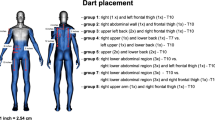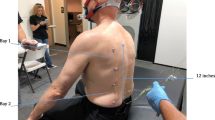Abstract
Conducted electrical weapons (CEW) are ubiquitous in law enforcement given their unique ability to physically incapacitate violently resisting subjects. Early use of animal models to study CEW incapacitation effectiveness (e.g. porcine model with 4-limb strain gauges) proved to be poorly predictive of human incapacitation effectiveness. In a previously published human study, we developed a methodology for the prospective assessment of the incapacitation effectiveness of CEWs in highly motivated human subjects. Here we use this methodology in Part 1 to compare the incapacitation effectiveness of the newly released Axon® (formerly TASER® International) T(ASER) 7 to the TASER X26E, the “gold standard”, and the TASER X2, a current model. The T7 has a new “adaptive cross-connect” technology that may improve incapacitation effectiveness in the scenario of small spreads between probe pairs, a common cause of weapon “failure” in the field. In Part 2, we use our methodology to test the functionality of the T7 cross-connect technology by comparing different bay and probe configurations. This is the first published study in the literature comparing different CEW models using this human model. For Part 1, 29 subjects completed the study and had data available for analysis. For Part 2, 21 subjects completed the study and had data available for analysis. The subjects were motivated to complete the task of reaching a suspended martial arts dummy 3.4 m (11 ft) away while being exposed “under power” to the CEW. In Part 1, subjects were assigned to 1 of 6 groups with probe spreads of 10, 20, and 30 cm (4, 8, 12 in). Subjects were exposed to a “control” CEW (either the X2 or X26E) and the T7 on alternating sides. Exposures with the X2 and T7 included 2 bay-exposures. In Part 2, 21 subjects were assigned to 1 of 5 groups of different T7 bay and probe configurations all with a theoretical effective spread of 30 cm (12 in). Subjects were rated on their progress towards successfully reaching the dummy and on the extent of limb incapacitation using a quasi-blinded expert-observer scoring panel based on high-speed video review. In Part 1, all CEW models achieved maximal or near-maximal subject control with the 30 cm probe spread. With probe spreads of 10 and 20 cm the pooled data showed the T7 to be superior to the X2 for goal achievement (p < 0.001) and limb incapacitation (p = 0.002) mostly driven by differences seen with the 10 cm spread (2-bay exposures). The T7 was non-inferior to the X26E. In Part 2, there was no statistical significance between the limb capture scores, but there was a statistically significant difference in goal scores. The results overall validate that the T7 CEW cross-connect feature performed as expected. The T7 adaptive cross-connect feature with two simultaneous deployed probe pairs demonstrated a significant improvement in incapacitation effectiveness compared to the current X2 CEW with two simultaneously deployed probe pairs. Small probe spreads are a common reason for limited incapacitation effectiveness in the field and this study suggests the T7 may offer an improvement in this scenario. The T7, with single-bay exposures, was non-inferior to the single-bay X26E.



Similar content being viewed by others
References
Sweeney JD. Transcutaneous muscle stimulation. In: Kroll MW, Ho JD, editors. TASER conducted weapons: physiology, pathology, and law. New York: Springer; 2009. p. 51–62.
Panescu D, Stratbucker RA. Current flow in the human body. In: Kroll MW, Ho JD, editors. TASER conducted weapons: physiology, pathology, and law. New York: Springer; 2009. p. 63–84.
Reilly J, Diamant A, Comeaux J. Dosimetry considerations for electrical stun devices. Phys Med Biol. 2009;54:1319–35.
Sun H, Webster J. Estimating neuromuscular stimulation within the human torso with TASER® stimulus. Phys Med Biol. 2007;52:6401–11.
Beason C, Jauchem J, Clark CD, Parker J, Fines D. Pulse variations of a conducted energy weapon (similar to the TASER X26 device): effects on muscle contraction and threshold for ventricular fibrillation. J Forensic Sci. 2009;54:1113–8.
Ho J, Dawes D, Miner J, Kunz S, Nelson R, Sweeney J. Conducted electrical weapon incapacitation during a goal-directed task as a function of probe spread. Forensic Sci Med Pathol. 2012;8:358–66.
White M, Ready J. The impact of the TASER on suspect resistance: identifying predictors of effectiveness. Crime Delinq. 2010;56:70–102.
TASER® X26 User Certification Course, Version 18, TASER International, released July 2011.
Funding
Axon Enterprise, Inc. provided funding for the study.
Author information
Authors and Affiliations
Corresponding author
Ethics declarations
Conflict of interest
Drs. Jeffrey Ho, Donald Dawes and Sebastian N. Kunz are paid as consultants to Axon Enterprise, Inc; Dr. Jeffrey Ho is the Axon Enterprise, Inc Medical Director and owns company stock. Dr. Sebastian N. Kunz is on the Axon Enterprise, Inc Scientific and Medical Advisory Board. Mr. Rajesh Satpathy, Drs. Lauren Klein, Brian Driver, and Jamie L Stang have no conflicts to declare.
Ethical approval
The study was performed in accordance with the ethical standards of the Minneapolis Medical Research Foundation and with the 1964 Helsinki declaration and its later amendments or comparable ethical standards.
Informed consent
Informed consent, supervised by Mr. Rajesh Satpathy, was obtained from all individual participants included in the study.
Additional information
Publisher’s note
Springer Nature remains neutral with regard to jurisdictional claims in published maps and institutional affiliations.
Rights and permissions
About this article
Cite this article
Ho, J., Dawes, D.M., Kunz, S.N. et al. A comparative study of conducted electrical weapon incapacitation during a goal-directed task. Forensic Sci Med Pathol 16, 613–621 (2020). https://doi.org/10.1007/s12024-020-00284-7
Accepted:
Published:
Issue Date:
DOI: https://doi.org/10.1007/s12024-020-00284-7




